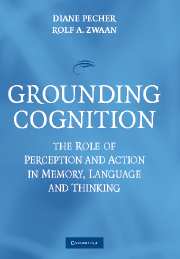Book contents
- Frontmatter
- Contents
- List of Contributors
- 1 Introduction to Grounding Cognition: The Role of Perception and Action in Memory, Language, and Thinking
- 2 Object Concepts and Action
- 3 Constraints on Spatial Language Comprehension: Function and Geometry
- 4 Embodiment in Metaphorical Imagination
- 5 Passionate Thoughts: The Emotional Embodiment of Moral Concepts
- 6 Grounding Language in Bodily States: The Case for Emotion
- 7 Situating Abstract Concepts
- 8 Dynamicity, Fictivity, and Scanning: The Imaginative Basis of Logic and Linguistic Meaning
- 9 The Emergence of Grammar from Perspective
- 10 Embodied Sentence Comprehension
- 11 On the Perceptual-Motor and Image-Schematic Infrastructure of Language
- 12 Connecting Concepts to Each Other and the World
- Author Index
- Subject Index
- References
8 - Dynamicity, Fictivity, and Scanning: The Imaginative Basis of Logic and Linguistic Meaning
Published online by Cambridge University Press: 22 July 2009
- Frontmatter
- Contents
- List of Contributors
- 1 Introduction to Grounding Cognition: The Role of Perception and Action in Memory, Language, and Thinking
- 2 Object Concepts and Action
- 3 Constraints on Spatial Language Comprehension: Function and Geometry
- 4 Embodiment in Metaphorical Imagination
- 5 Passionate Thoughts: The Emotional Embodiment of Moral Concepts
- 6 Grounding Language in Bodily States: The Case for Emotion
- 7 Situating Abstract Concepts
- 8 Dynamicity, Fictivity, and Scanning: The Imaginative Basis of Logic and Linguistic Meaning
- 9 The Emergence of Grammar from Perspective
- 10 Embodied Sentence Comprehension
- 11 On the Perceptual-Motor and Image-Schematic Infrastructure of Language
- 12 Connecting Concepts to Each Other and the World
- Author Index
- Subject Index
- References
Summary
COGNITIVE SEMANTICS
The last quarter century has seen the emergence of what has come to be known as cognitive semantics. This collective endeavor has vastly expanded and profoundly altered our view of both meaning and its relation to grammar. It offers new solutions to classic problems. More fundamentally, it reshapes the entire conceptual landscape within which the problems themselves are posed and formulated.
The most basic development is simply the unequivocal identification of meaning with conceptualization, i.e., the cognitive activity constituting our apprehension of the world (Langacker, 1987a, 2000; Talmy, 2000a, 2000b). Since the mind is part of the loop, linguistic semantics does not just reflect the external situations described, but inescapably incorporates particular ways of construing those situations and portraying them for linguistic purposes. It thus involves the full range of our mental capacities, as well as the elaborate conceptual structures we construct and manipulate. Included – being absolutely fundamental to cognition and language – are capacities reasonably called imaginative: metaphor (Lakoff & Johnson, 1980, 1999), metonymy (Kövecses & Radden, 1998), fictivity (Matsumoto, 1996a, 1996b; Talmy, 1996; Langacker, 1999b), mental space construction (Fauconnier, 1985; Fauconnier & Sweetser, 1996), and conceptual blending (Fauconnier, 1997; Fauconnier & Turner, 1998a, 1998b, 2002). These capacities are however grounded in everyday bodily experience: motion, perception, muscular exertion, etc. Basic experience of this sort is projected metaphorically onto other domains, and in abstracted form provides the skeletal organization of conceptual structure in general. This of course is embodiment (Johnson, 1987; Lakoff, 1987).
- Type
- Chapter
- Information
- Grounding CognitionThe Role of Perception and Action in Memory, Language, and Thinking, pp. 164 - 197Publisher: Cambridge University PressPrint publication year: 2005
References
- 26
- Cited by



